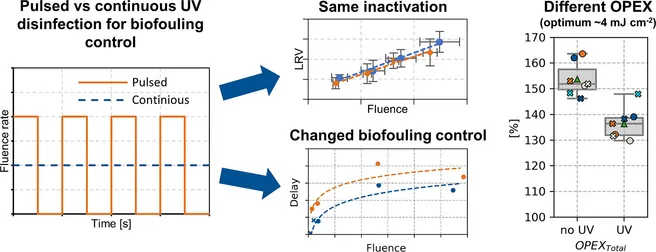Biofouling remains a major challenge for reverse osmosis (RO) systems. Pulsed ultraviolet (UV) pre-treatment has been proposed as a mitigation strategy for biofouling control of RO membranes. This study investigated whether increasing fluence rate during pulsed UV disinfection leads to enhanced inactivation. Further, UV irradiation from 1.5 to 61.3 mJ cm−2 was tested for optimal biofouling control. Therefore, an UVC-LED reactor was characterized by successfully adapting an actinometry method for flow-through mode. The inactivation of microorganisms was compared in flow-through biodosimetry experiments in pulsed and continuous irradiation. Finally, several settings were applied as pre-treatment in lab-scale biofouling experiments and membrane performance and biofilm removability elucidated. Whereas no enhanced inactivation was observed during biodosimetry experiments, pulsed UV disinfection resulted in an average of 20.6 % increased delay of biofilm formation. On the contrary, for pulsed UV disinfection, the biofilm hydraulic resistance seemed higher than continuous equivalents, but not significantly. Overall, savings of operational expenditures per fluence applied was highest around 4 mJ cm−2. UV pre-treated biofilms showed no enhanced removability, but delay in biofilm formation was noticeable in two of three experiments. In case the effects translate to up-scaled applications over several cleanings, UV pre-treatment for biofouling control is an interesting option.
